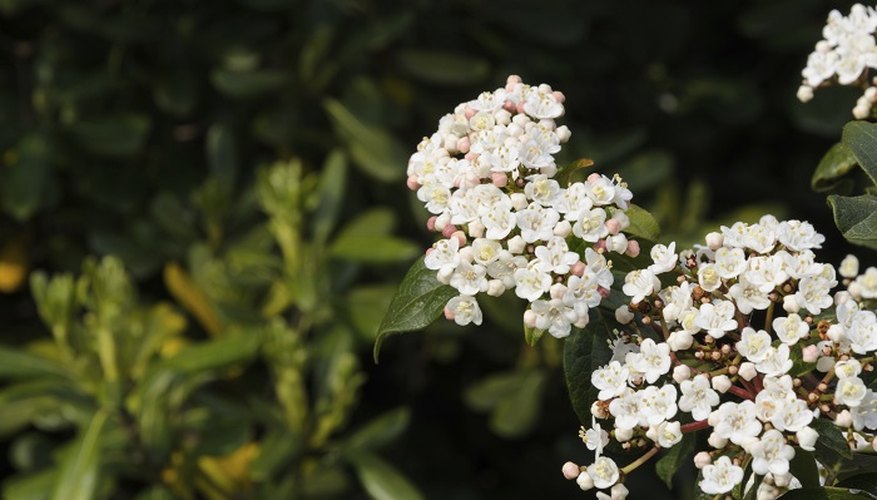A broadleaved evergreen shrub native to the Mediterranean basin, Viburnum tinus -- also known as Variegated laurustinus -- bears snow-white clusters of tiny blossoms in late winter that become blue-black fruits by summertime. Without any pruning, the shrub becomes rounded and upright, up to 3 metres (10 feet) tall and equally wide. Dozens of smaller-growing cultivars exist. Prune dead branches away any time of year. Trimming errant twigs or reducing the shrub size of a laurustinus should be scheduled for spring, immediately after the flowering display ends.
Pruning times
Viburnum tinus flowering wraps up in early April at the latest. Trim back branches to shape the shrub as needed right after the majority of flower clusters wither away. You sacrifice berry clusters if branch tips that just bloomed are trimmed away, but new growth that follows matures well before the onset of cold weather in autumn. Pruning in early spring also allows you to remove any tissues killed back by unusual winter cold.
- Viburnum tinus flowering wraps up in early April at the latest.
- You sacrifice berry clusters if branch tips that just bloomed are trimmed away, but new growth that follows matures well before the onset of cold weather in autumn.
Pruning considerations
Even without pruning, the laurustinus tends to develop an attractive, well-structured canopy. Light trimming of branch tips any time of year, except between July and the first autumn frost, is acceptable for shaping. More intensive branch rejuvenation pruning may be needed every five to six years in early spring. Rejuvenation involves cutting back the oldest branches to a lower branch junction and allowing new growth to resprout from buds below the prune wound. When rejuvenating, do not reduce an old branch by more than half of its original length.
- Even without pruning, the laurustinus tends to develop an attractive, well-structured canopy.
- Light trimming of branch tips any time of year, except between July and the first autumn frost, is acceptable for shaping.
Equipment
Trimming twigs and branches less than 2 cm (3/4 inch) in diameter on the laurustinus requires only sharp hand-held pruners or secateurs. If the branch measures up to 3.75 cm (1 1/2 inches) in thickness, use loppers to effectively cut the tissues. A pruning saw also works well on large-diameter branches, especially when cutting into old branches during rejuvenation pruning tasks. Hold the branch steady so that when the saw cuts through the wood the upper piece does not flop and tear back the bark as it drops.
- Trimming twigs and branches less than 2 cm (3/4 inch) in diameter on the laurustinus requires only sharp hand-held pruners or secateurs.
Healing wounds
Pruning laurustinus in early spring provides ample time for the plant to naturally form a callus and seal off open pruning wounds. The callus prevents water loss and prevents insects and diseases from gaining easy entry into the plant's vascular system. Do not paint or seal pruning cut wounds. Monitor the formation of the callus on the branches during the summer after pruning. Any strange gelatinous or foul-smelling sap or a growth rising from the wound may indicate infection. Diseased wood needs immediate pruning to fully remove it from the plant.
- Pruning laurustinus in early spring provides ample time for the plant to naturally form a callus and seal off open pruning wounds.
- Diseased wood needs immediate pruning to fully remove it from the plant.
